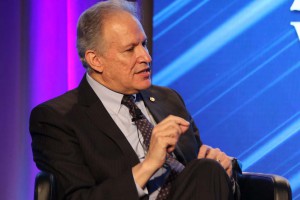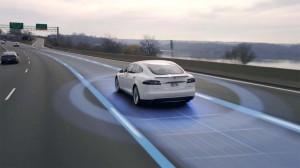
GM CEO Mary Barra said the company is rethinking its timeframe for the introduction of semi- and fully autonomous vehicles.
The fatal crash of a Tesla Model S using the maker’s Autopilot system appears to be having some serious repercussions across the auto industry as manufacturers and regulators re-think the rush to put semi- and fully autonomous vehicles on the road.
Among the automakers taking a “step back” is General Motors, where Chairman and CEO Mary Barra said the maker is taking another “look at what technology is in the best interest of consumers.” One consequence may be a delay in the roll-out of GM’s Supercruise, a system believed to be similar in function to the Tesla Autopilot.
Until recently, GM was indicating it would launch the Supercruise software on its new Cadillac CT6 sedan sometime in 2017. But at this point, Barra told reporters in Detroit, “We aren’t putting a specific date on it,” but officials later added the feature is still expected to debut in 2017.
The general industry consensus is that fully autonomous vehicles would begin to roll out early in the coming decade, but that semi-autonomous technology would start to phase in during the next few years. A number of automakers are advancing the technology with their 2017 models, including Mercedes-Benz, with the new E-Class sedan, and Tesla.
The California battery-carmaker’s Autopilot is a semi-autonomous system that can automatically change lanes, among other things. Tesla says motorists must still remain in control – while also stressing the system is still in “beta” stage. But there have been numerous reports of motorists pushing Autopilot well beyond what Tesla intended, a YouTube video showing one driver activating the system and then jumping into the rear seat.
On May 9, a former Navy SEAL, 40-year-old Joshua Brown, was killed in a Florida crash when his Model S failed to spot a truck turning into his lane. The Autopilot’s camera system couldn’t distinguish the white truck from a bright sky, and its radar mistook the truck for an overhead highway sign.
(GM’s tab for Takata may be $870 million. For more, Click Here.)
In recent weeks, two other Tesla crashes have been revealed, though there is debate over whether they involved the Autopilot system. But a number of critics have called on Tesla to disable the technology. The maker has rejected that idea, though CEO Elon Musk promises to upgrade the system. In the meantime, automakers and regulators alike are facing calls from groups like California-based Consumer Watchdog to slow the process of rolling auto self-driving technologies.
“It won’t be ready ’til it’s ready,” a senior executive within General Motors told TheDetroitBureau.com following CEO Barra’s appearance at a cybersecurity conference in Detroit on Friday morning. The automaker is determined not to repeat Tesla’s mistakes which, the official stressed, include putting out a high-tech system that is still in beta, or not fully trouble-free.
That said, GM insiders believe they should be able to avoid some of the problems Tesla has faced. Like Autopilot, the Detroit maker’s Supercruise will blend inputs from forward-looking cameras and radar. But GM’s system also will depend upon a high-definition map – much more detailed than what’s conventionally used in a car – to determine both where a vehicle is located and where it will be safe to activate Supercruise.
The GM system adds another feature, a retina detection system designed to constantly monitor the driver. It requires the motorist to always be aware of the road and ready to take control in an emergency, otherwise Supercruise will shut off.
(To see more about China’s move to shut down autonomous testing on highways, Click Here.)

NHTSA Administrator Mark Rosekind urged automakers to continue, not delay, the introduction of semi-autonomous vehicles.
There is some evidence driver Brown was distracted, possibly watching a video, when the Florida crash occurred. What’s clear is that when Autopilot missed the truck he failed to step in and hit the brakes.
While GM’s cautious approach to releasing the Autopilot system suggests the auto industry, more broadly, may take a “step back” to rethink the pace of introducing new technology, don’t expect the push for autonomous vehicles to come to a halt.
Indeed, while federal regulators are warning automakers not to take shortcuts on safety, they’re continuing an unusually proactive push for autonomous vehicles.
“We’ve got to move forward,” Mark Rosekind, the administrator of the National Highway Traffic Safety Administration,” said during the same cybersecurity conference where GM CEO Barra spoke.
(Click Here for details about GM’s reinvention, especially global propulsion.)
“We cannot wait for perfect,” added Rosekind, pointing out that the numbers of lives lost in U.S. highway crashes rose 8% last year after a decade of decline. “We will lose too many lives waiting for perfect.”


Today, even aeroplanes, massively built and on autopilot are subject to error.This against vehicle, they are more subject to risk. Problems can also be impacted by profitability which has been part in recent US auto industry. Roads,traffic,driving capability is integral part of the problem. Automatization has lowered cost, improved comfort, efficiency, but the fundamental problem here that automobile is mechanical component involving at the base level, quality of material, how well done and consequently affecting road safety and longevity.This had been a major part of Japanese market planning and main part of research while it far lagged the west. To many questions about innovation, if as much a blessing, yet as common example: what has innovation brought in, say, waking up a tired or drunk driver falling on the wheel?……..
* Online draft ( writer: S.A.E (retd)